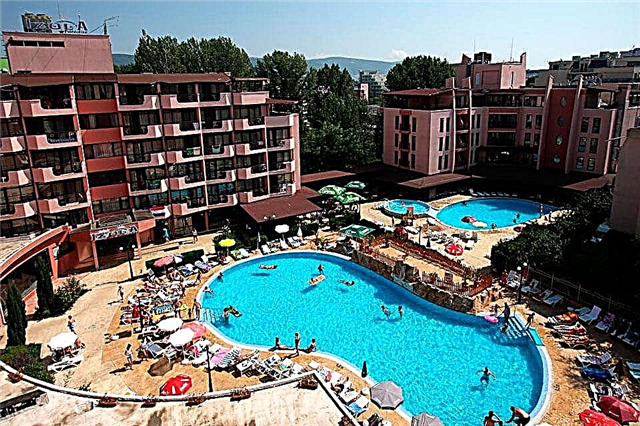Address: Russia, Saint Petersburg, Vasilievsky Island
Building: 1764 - 1780
Architect: Alexey Alekseevich Ivanov or Alexander Frantsevich Whist
Coordinates: 59 ° 56'23.1 "N 30 ° 16'59.2" E
Object of cultural heritage of the peoples of the Russian Federation
Content:
Each of the cathedrals and churches of St. Petersburg has its own unusual history. St. Andrew's Church on Vasilyevsky Island appeared at the behest of Tsar Peter I and received the status of a cathedral during the reign of his daughter, Empress Elizabeth Petrovna. The building, which has survived to this day, was built under Catherine II. The ancient cathedral has the status of the capitular church of the Order of St. Andrew the First-Called, and the nearby market is named after it.

Andrew's Cathedral from a bird's eye view
Temple history
Peter I considered the Apostle Andrew the First-Called to be his heavenly patron. When laying the foundation of the city on the Neva, the tsar placed an ark with the relics of the saint in the foundation of the stone fortress.
The Order of St. Andrew the First-Called was established in 1698. The honorary award was presented for outstanding military deeds and civil service. During the life of Peter I, 38 people became knights of the order, including the tsar himself. At the end of the 18th century, during the reign of Emperor Paul I, the Order of St. Andrew the First-Called received official status and became one of the most important awards of the Russian state.
At the beginning of the 18th century, the business and administrative center of the city is located on the Bolshoi Vasilievsky Island. Peter I well understood the importance of this place and wanted a new St. Andrew's Church to appear near the building of the Twelve Collegia.

View of St. Andrew's Cathedral from Bolshoy Avenue of Vasilievsky Island
In 1724, the Swedish architect Nicodemus Tessin Jr., on behalf of the king, took up the project. He fulfilled the will of Peter I and tried to make the future church resemble St. Peter's Basilica in Rome. The architect managed to prepare detailed drawings and a model, but in 1725 Peter I died, and the plans for the construction of the temple had to be postponed.
The inhabitants of Vasilievsky Island prayed in a small wooden church at the Menshikov Palace. There was not enough space for everyone, so the townspeople asked to build a more spacious parish church. By the decree of Empress Catherine I, 3 thousand state rubles were allocated for these purposes.
In 1729, Giuseppe Trezzini prepared an architectural project, and the construction began to boil with renewed vigor. Three years later, an associate of Peter I, Archbishop Theophanes, consecrated St. Andrew's Church. The iconostasis for her was brought from the house church of the Menshikov Palace, and Tsarina Anna Ioannovna donated money for the purchase of liturgical utensils and vestments.

View of St.Andrew's Cathedral from the obelisk in honor of the 300th anniversary of the establishment of the Order of the Holy Apostle Andrew the First-Called
The wooden temple was small and cramped. In the winter months it was not heated, so in 1745 a warm stone church was built nearby, which was dedicated to the Three Ecumenical Hierarchs. Many famous and wealthy people have attended church services in this temple. It is known that under the arches of the cathedral the professors of the Imperial Academy of Sciences Vasily Trediakovsky and Mikhail Lomonosov took the oath.
In 1761, tragedy struck. During a severe thunderstorm, the wooden church was struck by lightning and completely burned down. The parishioners were saved only by the carved iconostasis. The architect Alexander Frantsevich Vist prepared a new project, so in 1764 the construction of a stone building began.
Two years later, the unfinished dome of the temple suddenly collapsed. The architect was seized and arrested. Then the commission figured out that Whist was not guilty, and he was acquitted. In 1780, the construction, which had been dragging on for several years, was finally completed.

View of St.Andrew's Cathedral from the 6-7th line of Vasilievsky Island
At the end of the 18th - beginning of the 19th centuries, the cathedral was completed, altered and decorated. A fence with a chapel appeared near the temple. The interiors were decorated with stucco and paintings, and in front of the entrance they placed a bas-relief of the St.Andrew's Order, which was carried by two angels. Then the building was made warm and two chapels were added to it on the north and south sides.
At the beginning of the last century, there was a charitable society at the temple that helped the poor. An orphanage, an almshouse for the sick and a well-known folk choir were opened here.
In 1922, the seizure of church values was carried out throughout the country in favor of the starving in the Volga region. Silver and gilded vessels, crosses and frames of old icons were taken away from St.Andrew's Cathedral. For several years the temple was in the hands of the renovationists, who actively collaborated with the new government.

In the meantime, the city was growing and rebuilding. To expand the Leningrad boulevards, the cathedral chapel and part of the fence were demolished in the 1920s. Then the temple lost all its bells. At first they were transferred to the Peter and Paul Fortress, but then they were sent to be melted down. In 1938, by the decision of the Leningrad City Executive Committee, the cathedral was closed, the old iconostasis was filled with plywood sheets, and a warehouse was set up inside.
During the war, air defense troops operated in the temple. During shelling and bomb explosions, glass was broken, the roof, facade, interiors and a unique carved iconostasis were damaged.
When the war ended, the cathedral was restored and part of the collections of the famous Kunstkamera was placed inside. The building was returned to believers only in the early 1990s. After that, a major overhaul was made, and gilded titanium crosses appeared on the domes.

Cathedral domes
The architectural complex of the cathedral
The architecture of St. Andrew's Church was influenced by Baroque and Classicism. The main volume and the high hipped bell tower are connected by the refectory. The facades are painted in an elegant pale pink color and are decorated with pilasters and semicircular windows. The main dome is surrounded by four neat domes and vaguely resembles St. Peter's Cathedral. The temple bell tower is similar to the traditional bell tower of the Lutheran church.
On the north side of the cathedral is the ancient church of the Three Ecumenical Hierarchs. The red-and-white two-story temple, more than 250 years old, looks very harmonious. At the beginning of the 20th century, many ancient icons were kept in it. In the 1930s, the building was taken over by a knitwear factory, so the original interiors were completely lost. Today, church services are regularly held in the restored church.
Since 2007, the park near the cathedral has been decorated with a bust of the first cavalier of the Order of St. Andrew the First-Called, the closest associate of the tsar - Count Fyodor Alekseevich Golovin. In the times of Peter the Great, he headed the Ambassadorial Prikaz and was organizing the campaign of the Russian army against Azov. FA Golovin received the order for his long and devoted service personally from the hands of the tsar.

Sign of the Order of St. Andrew the First-Called over the entrance to the cathedral
At the corner of the temple fence, near Bolshoy Avenue of Vasilievsky Island, there is an elegant chapel of Prince Vladimir. This beautiful one-storey building was built in 2001 in the best traditions of classicism and is decorated with strict triangular porticoes and columns. A pictorial icon of St. Vladimir hangs above the entrance.
Cathedral inside
The temple is very spacious and light. The walls are richly decorated with intricate stucco moldings and paintings on religious themes. The beautiful Gospel and altar vestments made of silver, which weigh more than 110 kg, catch the eye.
The gilded iconostasis of the 18th century, one of the oldest in the city, has miraculously survived in St.Andrew's Cathedral. It has a height of 17 m. On the three-tiered carved iconostasis, you can see ancient images from the house church of Prince Alexander Menshikov and other icons that were painted at a later time.

Interior of St. Andrew's Cathedral
Memorial obelisk
To the south of the cathedral, on Andreevsky Boulevard, rises an original four-sided obelisk dedicated to the 300th anniversary of the Order of St. Andrew the First-Called.The historical monument appeared in 2001, when the pedestrian zones between the 6th and 7th lines of Vasilievsky Island were being formed. It fits perfectly into the surrounding 300-year-old buildings.
The stone stele stands on a high granite pedestal and has a height of 8 m. Its edges are inlaid with oblique crosses, which symbolize the crucifixion of the Apostle Andrew. Above you can see the image of the sign of the Order of St. Andrew the First-Called. On one side of the Orthodox cross there is a two-headed eagle, and on the other - the crucifixion of the apostle. Bronze plaques with texts are fixed on the edges of the obelisk.
Useful information for visitors
One of the oldest and most revered temples in the city receives pilgrims and tourists daily from 8:00 to 19:00. The entrance to the cathedral is free. Church services are held twice a day at 10:00 and 17:00. The church has a church singing class and a Sunday school for adults and children.

Iconostasis of St.Andrew's Cathedral
How to get there
The cathedral stands in the historic heart of the city, 0.4 km from the Vasileostrovskaya metro station.











